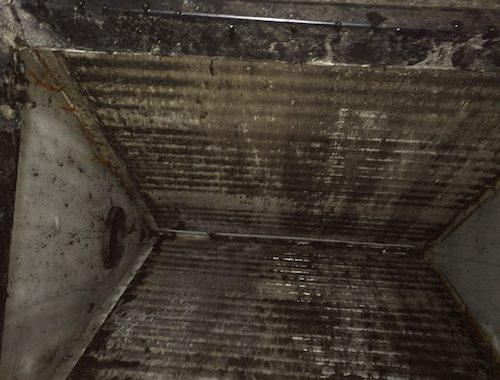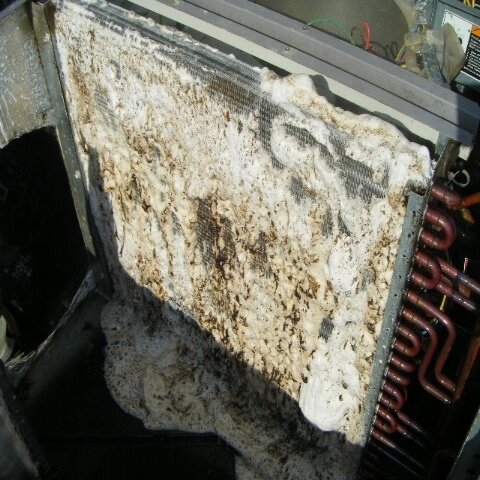To clean mold from air conditioner coils, remove the access panel and use a commercial cleaner or a mild detergent solution. Apply the solution with a soft brush, then rinse with water and dry thoroughly.
Ensuring your air conditioner functions efficiently involves regular maintenance, including cleaning the condenser and evaporator coils. Mold on these coils can significantly decrease your system’s efficiency and pose health risks by contaminating the air you breathe. A well-maintained air conditioner not only improves air quality but can also reduce energy costs and extend the life of the unit.
Tackling mold promptly on AC coils is crucial for preventing potential respiratory problems and keeping energy bills low. Engaging in this task requires safety precautions, like powering off the unit and using the correct cleaning agents to avoid damage. Regularly cleaning your air conditioner coils is a key component of household maintenance for a comfortable, safe, and efficient living environment.
Introduction To Mold In Air Conditioning Systems
Mold thrives in damp, dark places. Air conditioner coils create the perfect environment for mold growth. Keeping them clean is crucial for your health and your AC’s efficiency.
Understanding Mold: What It Is And Why It Grows On AC Coils
Mold is a type of fungus that can grow indoors and outdoors. It reproduces by releasing spores that travel through the air. AC coils, which condense moisture from the air, can become wet and invite mold.
- Spores need moisture to grow.
- AC units provide a constant moisture source.
- Dark interiors of AC systems protect mold from sunlight.
The Health Risks Associated With Mold In Your Air Conditioner
Mold exposure can lead to health problems. People with asthma or allergies may be more sensitive. Some potential health issues include:
- Nasal stuffiness
- Throat irritation
- Coughing or wheezing
- Skin irritation
- Eye irritation
Children, the elderly, and those with immune suppression are particularly at risk.
Recognizing Signs Of Mold In Your Air Conditioning Unit
Look out for telltale signs that mold is present:
| Signs of Mold | Detection Method |
|---|---|
| Musty odors | Smell around the AC unit |
| Visible growth | Check for black, green, or white spots |
| Allergy symptoms | Note if symptoms improve away from AC |

Credit: www.jeremykc.com
Preparation For Cleaning Mold From AC Coils
Before tackling mold on AC coils, proper preparation is essential for a safe and effective cleaning process. The right approach ensures that you eliminate the health hazard that mold presents. It also helps maintain your air conditioner’s efficiency. Follow these steps to gear up for mold removal from your AC coils.
Safety First: Protective Gear And Precautions
Safety should be your top priority. Exposure to mold and chemicals during cleaning can be hazardous to your health. Ensure you are well-equipped with the following protective gear before you start:
- Gloves: Wear thick gloves to protect your hands from mold and cleaning agents.
- Respirator Mask: Use an N95 respirator to prevent mold spore inhalation.
- Safety Goggles: Protect your eyes from harmful chemicals and mold spores.
- Coveralls: Optional protective clothing can prevent skin contact with mold.
Additionally, open windows or use fans for ventilation, and ensure no power is running to the unit during cleaning.
Tools And Materials You Will Need For The Cleaning Process
The right tools make the job easier and more effective. Gather the following for a seamless cleaning experience:
- Soft Brush: For gentle scrubbing of coils.
- Mold Cleaner: Choose a cleaner specifically for air conditioners.
- Spray Bottle: For even application of the cleaning solution.
- Fin Comb: To straighten any bent coil fins.
- Microfiber Cloth: Use to wipe and dry the coils post-cleaning.
- Vacuum with HEPA Filter: For cleaning dust and loose mold spores.
Shutting Down The AC Unit: Ensuring A Safe Cleaning Environment
Turn off your AC unit completely before starting the cleaning process. Do this either at the thermostat or the main breaker. This step prevents electrical accidents and allows the coils to be free of any residual electric charge.
| Action | Reason |
|---|---|
| Switch off the thermostat | Stops the AC from kicking on during cleaning |
| Cut the power at the breaker | Ensures complete safety from electrical hazards |
After shutting off the power, confirm there’s no electrical activity in the unit. Now your preparation is complete, and you can safely begin cleaning the mold from your AC coils.
Step-by-step Guide To Clean Mold From Air Conditioner Coils
A clean air conditioner is crucial for efficient performance and air quality. Mold on AC coils can affect both. This guide will show you how to remove mold and ensure your unit runs smoothly.
Accessing The AC Coils: Removing Panels And Accessing The Interior
Start by powering off your air conditioner. Remove the front panel and any additional covers to expose the coils. Use a screwdriver if needed. This allows full access to the interior for a thorough clean.
Dry Brushing: Removing Loose Mold And Debris From The Coils
With a soft brush, gently sweep across the coils. This removes loose spores and debris. Be gentle to avoid damaging the fins.
Applying Cleaning Solution: Selecting The Right Mold Cleaners For The Job
Choose a cleaner designed for AC units. It should be mildewcide-formulated. Apply it according to the product’s instructions for safe and effective usage.
Thorough Scrubbing: Techniques For Removing Stubborn Mold Growth
Use a soft-bristle brush or a fin comb for scrubbing. Work in smooth, straight motions. Tackle stubborn mold with careful but firm strokes. Never use excessive force.
Rinsing And Drying: Ensuring No Cleaner Residue Is Left Behind
After scrubbing, rinse the coils gently with water. Avoid high pressure that can bend the fins. Allow the coils to dry completely. A fan can speed up this process.
Replacing Or Cleaning Air Filters: Completing The Mold Removal Process
Evaluate your filters. If they are reusable, clean them thoroughly. If they are disposable, replace them with new ones. Reinstall the panels once everything is dry.

Credit: molekule.com
Preventing Future Mold Growth In Air Conditioning Systems
Ensuring your air conditioning system remains mold-free is crucial for air quality. Proper and regular maintenance can prevent mold from becoming a recurring issue. Let’s explore effective strategies to keep your AC system clean and healthy.
Routine Maintenance: Scheduling Regular Cleaning And Inspections
- Monthly filter changes keep the air clean.
- Seasonal inspections by professionals prevent mold.
- Cleaning coils and drain pans every spring maintains effectiveness.
Improving Ventilation And Airflow: Tips To Keep Coils Dry
- Ensure ducts are unobstructed for maximum airflow.
- Install dehumidifiers to reduce moisture levels.
- Regular use of AC helps to circulate air and control humidity.
Using Mold Inhibitors And UV Lights For Long-term Protection
Mold inhibitors applied to coils create a protective barrier. UV light installations in AC units target mold spores. These long-term solutions help keep air conditioning systems clean.
When To Call A Professional: Recognizing Your Limits
Cleaning mold from air conditioner coils might seem straightforward at first glance. Yet, assessing when to call in professionals can save you time and ensure safety. Discovering a mold problem in your home’s air conditioning system can quickly become a health hazard, and sometimes a basic cleaning isn’t enough. Recognize your limitations when tackling this issue.
Understanding When Professional Intervention Is Necessary
- Complex systems: If your AC unit is intricate, leave it to the experts.
- Recurring mold: Seeing mold return after a clean points to a deeper issue.
- Health concerns: People with mold allergies need professional cleaning.
The Benefits Of Professional AC Maintenance And Mold Remediation
- Thorough cleaning: Professionals reach parts you might miss.
- Improved air quality: Expert mold removal ensures cleaner indoor air.
- Longevity: Regular maintenance can extend your AC’s lifespan.
How To Choose The Right HVAC Professional For Mold Removal
Select a certified HVAC technician with:
| Criterion | Why It Matters |
|---|---|
| Experience | Expertise in mold-related problems is essential. |
| Reputation | Look for positive reviews from past clients. |
| Licensing | A license ensures they’re approved for the job. |
| Insurance | This protects you from liability during service. |

Credit: www.affordablecomfortaz.com
Can the Same Cleaning Method for Microchannel Coils be Used for Regular Air Conditioner Coils?
Yes, the same cleaning method for microchannel coils can be used for regular air conditioner coils. It’s important to use a non-acid-based cleaner and a soft brush to avoid damaging the delicate fins. Regular maintenance of cleaning microchannel coils will ensure optimal performance and energy efficiency of the air conditioner.
Frequently Asked Questions On How To Clean Mold From Air Conditioner Coils
What Kills Mold On AC Coils?
A HVAC professional can apply a specialized cleaning solution designed to eliminate mold from AC coils effectively. Regular maintenance also prevents mold growth.
Can You Clean Mold Out Of An AC Unit?
Yes, you can clean mold out of an AC unit by using a commercial mold cleaner, ensuring the unit is turned off and following the manufacturer’s instructions for cleaning. Regular maintenance can prevent mold growth.
What Is The Black Stuff On My AC Coils?
The black stuff on your AC coils is likely mold or dirt accumulation, which can impede efficiency and requires cleaning.
Does Mold Grow On AC Coils?
Yes, mold can grow on AC coils due to moisture and dust accumulation, creating a breeding ground for spores. Regular cleaning and maintenance prevent mold growth.
Conclusion
Keeping your air conditioner coils clean is essential for both air quality and efficiency. With these straightforward steps, mold can be eliminated, ensuring a healthier environment and smoother operation. Regular maintenance not only prolongs your AC’s lifespan but also saves on energy costs.
Remember, a bit of prevention is worth a ton of cure!
As an Amazon Associate, Cleanestor earns from qualifying purchases at no additional cost to you.